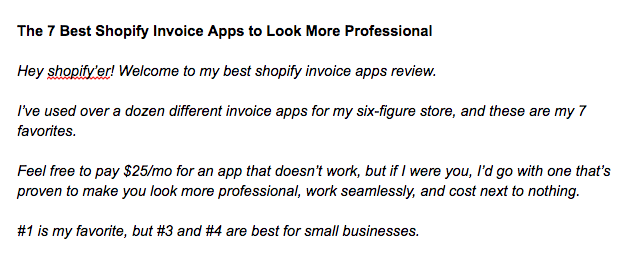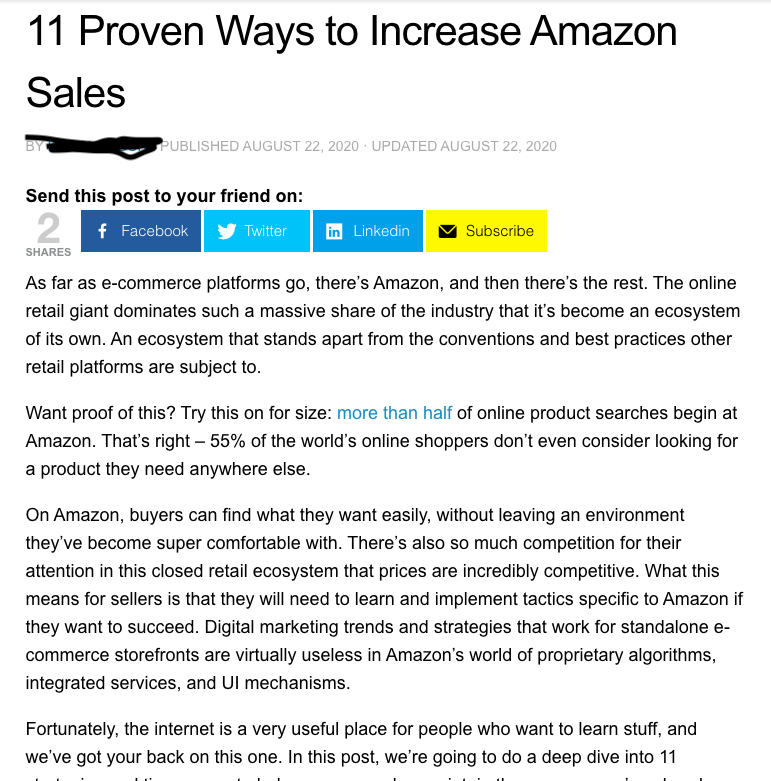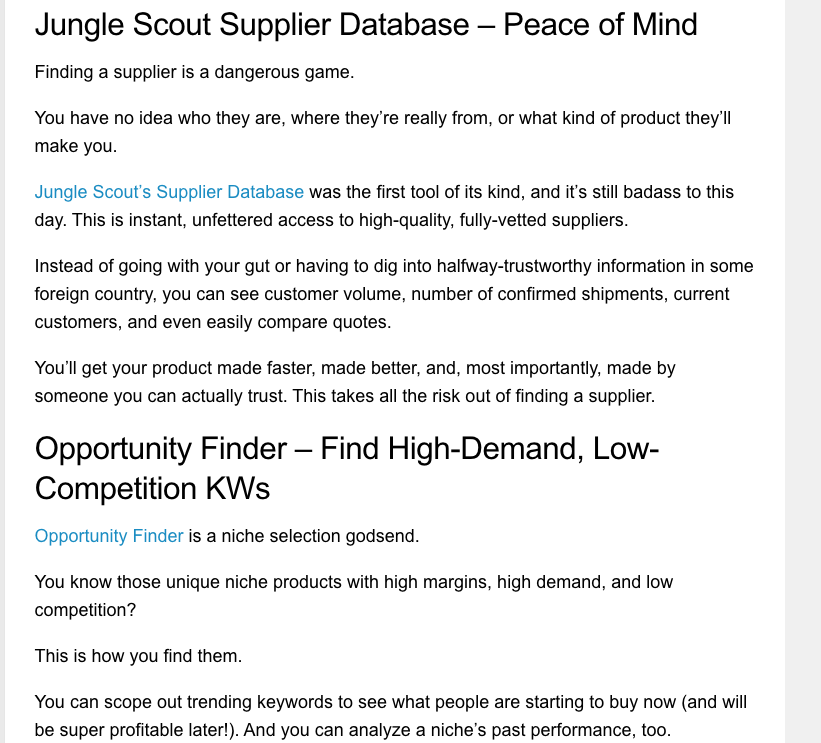How to Evaluate a Site’s Content Before Buying: Five Mistakes to Look for (and How to Fix Them)
Hey EF fans,
Today, I want to talk about one of the lowest hanging pieces of fruit in website flipping: improving low-quality content.
Sites with bad content—and there are tons of them—hold major opportunities for growth. Even relatively minor changes can result in major spikes in conversions, upping your eventual exit price by a nice margin.
In this post, I’ll identify the most common niche site content mistakes and how to fix them for quick wins. I’ll also include a case study to show you how my writing principles resulted in cool earnings and the spike in ordered items you see down there.
Let’s get to it.
Low-Quality Content: The Lowest-Hanging Fruit
The hungry website flippers I know are always on the hunt for sites with low-hanging fruit.
And for good reason. Nobody wants to buy an expensive site that’s already reached its full potential.
Where’s the fun in that?
Most of my clients want a high-potential site so they can buy low, aggressively scale, and flip it six months later for 10 times the original investment.
In my experience, the easiest way to improve a site’s revenue is to improve its content.
I often fully rewrite the top ranking or higher traffic articles on my client’s sites. This nearly always results in spikes in engagement metrics (e.g., time on page), clicks, and sales (for product reviews).
Check this out.
The top four articles are my own articles or rewrites of past previous articles. Notice how much more revenue they’re generating than the leftover articles from the previous writer? And it’s not just revenue, either. Look at the Total Items Ordered, too.
It’s not a fluke.
I’m not showing you this to brag—I want to demonstrate just how much potential there is in improving poor-quality content on your niche site.
Even adding an extra $500/month to your site’s earnings could increase your exit price by $15,000.
When doing your due diligence before buying a site, I highly recommend keeping an eye out for these five content mistakes. They are by far the most common and easiest to fix!
The Top Five Content Mistakes on Affiliate Sites
1. Bad Intros
This is the #1 mistake on all web content and my #1 pet peeve.
The intro is the most important part of an article. This is where the reader chooses between investing time in the article and going back to Google.
That means your intro must HOOK the reader and convince them to read your article or, if you’re an affiliate, buy what you’re reviewing.
The vast majority of writers, even from notable publications, get the intro wrong.
How often do you see intros like this?
Does someone searching “how to increase Amazon sales” need to know that Amazon is the leading e-commerce platform?
No.
How about this one?

Nope.
Do they need to know that they need to decide which invoice app to use?
No, they’ve made that decision already. Actually, I have a sneaking suspicion that’s what made them search for this term in the first place.
Someone looking for a list of the best Shopify invoice apps is looking for an authority on the topic to tell them which app is best for their particular situation.
They don’t need the backstory; they’re well aware.
Remember this: you have to meet your customer where they are.
This is a key copywriting concept that I try to drill home to all my clients.
Do not waste your reader’s time by telling them things they already know, or worse, things they don’t need to know.
Take a look at how much better this invoice app intro sounds when rewritten to meet the customer where they are (i.e., looking for a trustworthy review of invoice apps to make a purchasing decision).
You must hit one of the key “purchasing emotions” in your intro if you want to drive sales. In this case, I’ve used trust since most buyers are looking for a trustworthy source. What makes YOU the authority on this topic? Why buy from you and not someone else?
It flat out works.
Check out this graph from one of my UK-based clients. This happened after only changing his intro from explanatory to trust-focused and cleaning up the fluff.
Not bad!
TL;DR: Do not waste your reader’s time by telling them what they already know in your intro. Instead, use it to convince them to invest time in your article!
2. Incongruent Tone
Source: BBC.com
In general, web content should be more casual than professional. There are exceptions, of course. This is just a rule of thumb.
However, I usually see content written in a tone that’s incongruent with the topic or audience.
How often do you see content like this?
Does this sound like we’re talking about email marketing?
No.
I call this Sir David Attenborough Syndrome.
Sir David is the best nature documentary narrator of all time, but niche site content shouldn’t sound like you’re narrating a day in the life of the tasseled wobbegong.
When evaluating a site’s content, ask yourself the following question: Does this content sound like a real person having a real conversation on this topic, or does it sound like a web writer trying to be overly professional?
If it’s the latter, then there’s room for improvement.
Let’s revisit the increasing Amazon sales blog for a moment.
Most of us in this business are familiar with Amazon, right?
So, ask yourself, does this sound like someone who sells products on Amazon naturally speaking about the topic?
Not really, in my opinion. It sounds more like introductory business journalism than it does an eCommerce expert teaching you about making sales.
Actually, that’s the problem in a nutshell: too many web writers want to be journalists instead of good web copywriters. It’s a totally different game.
Now, compare the previous Amazon content to this loosely related article about Jungle Scout, an Amazon tool. Doesn’t it sound more like an eCommerce expert speaking about the topic?
It doesn’t sound like some Wall Street Journal article on Jungle Scout.
This writer doesn’t say things like “this stunning business tool is a fulcrum of a thriving eCommerce ecosystem dominated solely by one name and one name only: Amazon.”
The point I’m trying to make here is that, when evaluating a site’s content, you should look for content that’s clearly incongruent with the topic.
For example, I see a lot of listings on the EF marketplace for technology or sports sites, two niches that should clearly not be overly professional. If you notice the content is written in an incongruent tone, that’s an easy win, in my opinion.
All you have to do is write more casually. That usually means using more common words, shorter and more direct sentences, contractions, slang, and even a bit of mild profanity, such as “kicka**!” Avoid overly “journalistic” English phrases like “thriving ecosystem,” “fulcrum of modern business,” or “burgeoning sector of immense immensity.”
Pro tip: Watch YouTube videos in your niche to hear how real experts talk about the products/culture. You can learn a lot.
3. Bad Formatting
I hate to keep picking on this Amazon article. It’s really not that bad, but it does make a key mistake: walls of text.
This one is simple, so I won’t go into deep detail.
Walls of text are a huge turn-off. I’ve seen some quick improvements lead to upticks in engagement like time on page and clicks.
In general, readers want a simple and seamless reading experience. That means short sentences, lots of white space, and frequent pattern interruption.
Many of my clients are shocked when they see how frequently I use single-sentence paragraphs, but it does work. Check out my Jungle Scout article from before.
Short sentences, short paragraphs, lots of white space, paragraphs of varying length . . . these are key for user engagement.
If one of your potential acquisitions has a backlog of articles with bad formatting, just hiring a VA to go through and polish it up a bit could be a very quick and easy win.
NOTE: Sentence length is also a formatting factor. Long sentences are hard for the brain to digest. If the articles have long sentences with tons of punctuation, break them up into shorter sentences. There’s nothing wrong with stopping a sentence in the middle and beginning the next one with a conjunction.
4. Fluff Not Value
This is the trickiest one; even I struggle to train writers to do this correctly.
However, there are a few basic things you can do to provide more value.
But first, let’s start with HOW to evaluate content for value.
Start by reading the content and pretending you’re the reader. Does it give you information that you can actually use? Do you feel like you’re learning something useful? Check to see if it wastes time telling you things you don’t really need to know or can’t implement practically.
Here’s a good example.
Notice how this writer just kind of says nothing here?
What about this one from TechRadar?
Everything about this paragraph is wrong.
There are lots of cliches, empty statements, and surface-level information. This is, indeed, the shallow end of the pool. “The editing features will bring us there, and it won’t disappoint?.” Not very insightful writing.
Content must be detailed AND benefits-driven. You must not only provide the reader with information, but also tell them WHY that information is important and HOW to implement it.
Here are a few questions I’d address in the above content:
- What are PhotoScape’s accomplishments?
- What are the editing features, and how do they compare to competitors?
- How is having settings at the bottom of the screen an advantage? How can I even use them?
- Is the unusual interface a deal breaker? Can you get used to it?
Once again, I’d like to turn your attention to the blog about increasing Amazon sales.
Here’s the first subsection.
I find that most writers feel the need to set the scene or tell a story rather than get straight to providing value to the reader. This is an engagement killer.
On the web, you have precious few seconds to win a reader’s attention.
In this example, the writer wastes a lot of time telling the reader things they either already know or do not need to know. Nothing relevant appears until halfway through the second paragraph, at “your product listing is everything.”
They could have just led the section with that. Instead, it’s buried under a mountain of fluff.
This writer doesn’t get to the actual tips until the third paragraph. They spend two paragraphs setting the scene.
Here’s another example to illustrate my point better.

The value of the section is at the bottom!
This writer uses the first four paragraphs to ramble on about something the reader gets no value from.
Just tell them how to clean their boots!
They set the scene with 150 words while the reader is sitting there thinking, “Tell me something I need to know, please!”
Now read the following version. I’ve rewritten this content to include only value.
Notice how this is more informative and engaging?
Yes, I do set the scene a little before getting to the tips, but, in this case, the information I convey serves a purpose: it reinforces WHY the reader should listen. Notice that I use a bit of fear to encourage the reader to heed my warning (i.e., you’ll turn an ankle!).
Okay, Kevin. So what’s the point in all this?
The point I’m trying to make is that your content must convey value. The more in-depth and practical the advice, the better.
Reread the fluff in the increasing Amazon sales and cleaning your hiking boots articles.
There’s not much value in it at all. It’s just making general statements about the topic.
This kind of content is an engagement killer. It:
- increases the bounce rate,
- decreases sales/conversions,
- decreases return visitors,
- decreases social sharing; and
- hurts your brand image.
I don’t think this is necessarily a quick win—it’s more of an easy area for improvement. If you have a prospective site that’s already bringing in traffic with bland, fluff content, then improving engagement, clicks, conversions, etc. is as easy as hiring a better writer and letting them know that you won’t tolerate fluff or hiring a cheap writer and trimming the fat yourself.
5. Boring Product Reviews
People looking for product reviews are in buy-now mode. That means you need to show them sales copy or, more accurately, a mix of sales copy and traditional web content.
Boring, informative content is NOT going to drive sales.
Sure, some readers will buy, but the majority won’t be convinced by just listing the specs and key features.
Sales copy requires benefits, energy, and purchasing emotions like fear or trust.
The listing above does nothing but bore the reader to oblivion. I call these obituary reviews because they’re about as exciting as a death notice.
Of course, you need to strike a balance. You don’t want to be too salesy—you’ll lose the reader’s trust. but you definitely can’t bore them.
If you’re looking to buy a typical product review site, this is HUGE. If you’ve got decent traffic but low conversions, writing better sales copy could result in huge wins like below.
Here are a few tips for better product copy.
- Benefits NOT features: Nobody cares about how many centimeters a pool table’s surface is. They care that a smaller surface makes it easier to sink a ball and results in a more fun experience.
- Positioning: How does this one compare to competitors? One trick I always use here is saying it’s basically the same as x product but costs less.
- Emotions: You must trigger emotions like fear or trust if you want to make sales. People buy on emotion, not logic. Think about all those infomercials on TV claiming that the product will help you lose 15 pounds in 2 weeks. People are buying not only because they want to look better, but also because of the speed and convenience. If the commercial just told you to decrease your calorie intake by 15%, exercise, and get enough sleep to lose 2 pounds per week over the next 3 months, nobody would buy. One is emotion; the other is logic. Logic loses out.
- Personal experience: I’ve found that readers respond to your personal experiences with the products. Keeping with pool tables—how many bounce outs were there? How hard was it to sink a ball? How did it look in your basement? That kind of stuff. I often add sentences like this to the review copy: “Overall, this was the best for beginners out of all that we tested. I’m new to billiards and even I made some tough shots that I usually miss on other tables. That’s saying something!”.
Let’s Wrap Things Up…
I’ve been a writer in the SEO/digital marketing world for six years. Since Day 1, I’ve been trying to convince this industry that content is NOT a commodity to be produced en masse and sold to the lowest bidder.
In fact, it’s the opposite.
Content is a powerful tool for engaging your audience, pleasing Google’s algorithm, and converting traffic to buyers. Even minor improvements to existing content could result in huge wins.
So, next time you’re evaluating a site, ask yourself this: Which of Kevin’s content mistakes do I see on this site?
The more, the better, I assume. If there’s good SEO and steady traffic, improving the content could result in huge wins.
I’ve seen it time and again.
Actually, my SEO copywriting course—Web Copy Masterclass—is based around all of these mistakes you see here.
I’ve found that a lot of people in the SEO world don’t even know how to tell good content from bad content. I hope this article has helped.
Thanks for taking the time to read.
Happy flipping everyone!




![[GP - FINAL DRAFT] How to Evaluate a Site’s Content Before Buying: 5 Mistakes to Look for](https://d1u4v6449fgzem.cloudfront.net/wp-content/uploads/2020/11/09221026/How-to-Evaluate-a-Sites-Content-Before-Buying-Five-Mistakes-to-Look-for.png)















